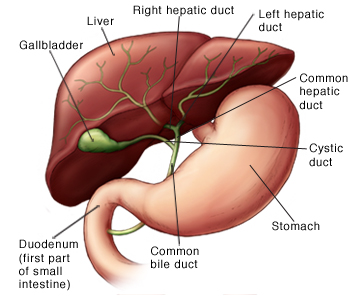When Your Child Has Biliary Atresia
When Your Child Has Biliary Atresia

The liver makes a substance called bile. It helps with digestion of food and helps carry waste out of the liver. Bile drains out of the liver through tubes called bile ducts. It drains through these ducts into the duodenum (the first part of the small intestine). If a child has biliary atresia, it means that some or all bile ducts aren’t formed correctly, are damaged, or are missing. As a result, bile can’t drain from the liver as it should.
What causes biliary atresia?
Biliary atresia is a congenital condition. This means that babies are born with it. Healthcare providers are not sure what causes it.
Signs and symptoms of biliary atresia
Some babies have signs of biliary atresia at birth or within the first 2 weeks of life. In other babies, signs don’t appear until around 2 to 8 weeks of age. These signs include:
-
Jaundice (yellowing of the skin and whites of the eyes, dark yellow urine, or light-colored stools-gray or clay color). This is due to a buildup of bilirubin, a yellow substance made when the body breaks down red blood cells. Normally, bilirubin is collected by the liver and sent out of the body with stool. When bilirubin can’t drain out of the liver through the bile ducts, it builds up in the body, leading to jaundice.
-
Problems absorbing vitamins and minerals, leading to signs of malnutrition.
-
Very pale stools.
-
Scarring of the liver.
-
An enlarged spleen (due to slowing of blood flow through the liver).
How is biliary atresia diagnosed?
To start, a health history will be taken and a physical exam done. The following tests may then be done:
-
Blood tests can reveal signs of liver disease.
-
Ultrasound helps rule out some causes of abnormal blood test results. During this test, harmless sound waves are used to form an image of the liver, gallbladder, bile ducts, and blood vessels feeding the liver.
-
A HIDA scan checks the function of the bile ducts. A radioactive fluid (marker) is put into the body. As this marker travels through the bile ducts to the intestines, it can be seen on a scan. The marker can show whether bile ducts are missing or blocked. This scan is not used frequently at this point.
-
Liver biopsy detects signs of damage in liver tissue. It can also sometimes point to the cause of the damage. During this test, a small hollow needle is used to remove a tiny amount of tissue from the liver. This tissue is studied in the lab.
-
Intraoperative cholangiogram is a procedure that may be needed if a diagnosis can’t be made based on other test results. A surgeon makes an incision near the liver. Through this, the surgeon looks at the bile ducts and injects contrast fluid into them. This can show problems with the bile ducts. If this test is needed, it’s often done at the start of the surgery that treats biliary atresia (see below).
- ERCP. Endoscopic retrograde cholangiopancreatography. This is a procedure where a lighted tube is placed down the mouth into the small intestine to get a better idea of the cause of biliary disease
How is biliary atresia treated?
Biliary atresia is treated with surgery using the Kasai procedure. During this surgery, abnormal bile ducts outside the liver are removed. The small intestine is then attached directly to any working ducts. This lets bile drain into the intestine. It is best if surgery is done soon after diagnosis, often within a few days. The younger a child is when surgery is done, the better the outcome tends to be.
What are the long-term concerns?
Without treatment, a child with biliary atresia will likely live only a few years. Surgery helps manage the disease, and often has good results for many years. But surgery is not a cure for biliary atresia. Many children with biliary atresia eventually need a liver transplant.
Biliary atresia in older babies
In rare cases, biliary atresia isn’t diagnosed until the child is 3 to 4 months old. Treatment may be different for these children. Your child’s healthcare provider can tell you more. An older baby with biliary atresia may have:
-
Malnutrition
-
Poor growth
-
Swollen abdomen due to fluid in the abdomen (ascites)
-
Portal hypertension (abnormally high pressure in the blood vessels feeding the liver)
-
Intestinal bleeding
-
Severe scarring of the liver (cirrhosis)
Updated:
June 04, 2019
Sources:
Biliary Atresia. UpToDate., Biliary Atresia: Clinical Lessons Learned. Feldman Amy G. Journal of Pediatric Gastroenterology. 2015;61(2):167–175.
Reviewed By:
Jen Lehrer MD,Kenny Turley PA-C